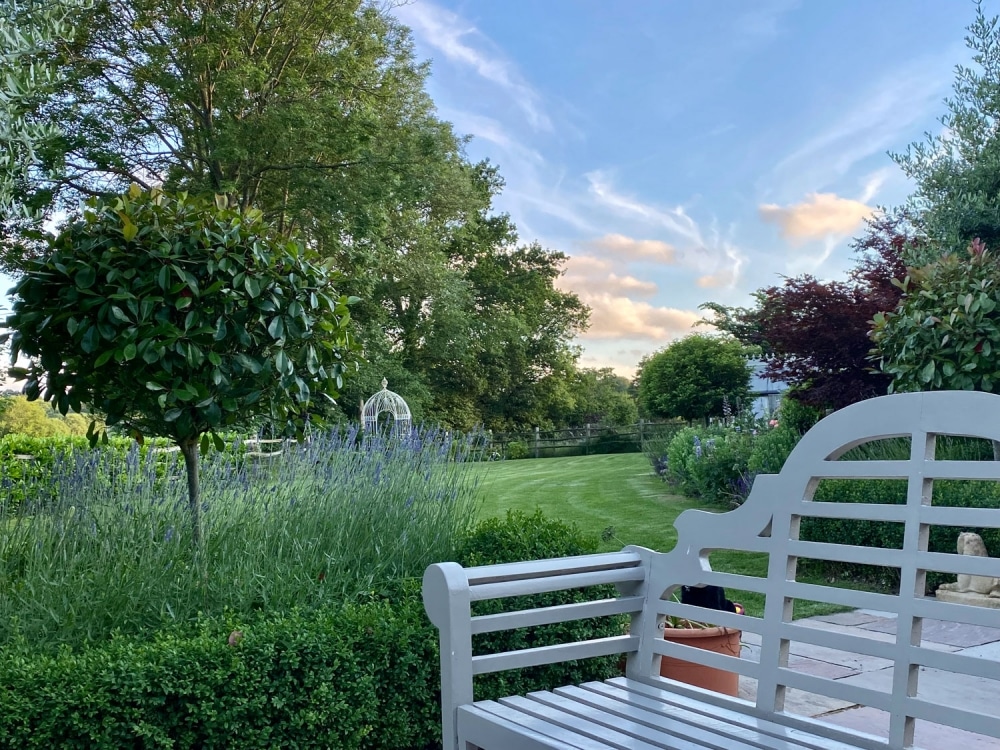In a photograph, or painting the focal point is the point of interest that helps make it unique. A garden is no different, here we are creating our own organic picture, that hopefully pleases and engages for years to come.
It’s more complex, because in that it lives and breathes and changes throughout the seasons. Where we look and admire, can be helped by the judicious use of focal points and how we surround and frame these.
Focal points can be objects, or features situated inside, or outside a garden that draw the eye. They can be a tree, pond, a Chilstone fountain, a sculpture, a bench, a summerhouse, rose gazebo, an architectural feature, some distant object, or even a building that commands your attention.
In a small garden, or courtyard a singular focal point maybe sufficient. In a large garden you might create a number of focal points, using each one to draw the visitor from one interesting part of the garden to another. Sissinghurst Gardens are an excellent example of this, where carefully positioned trees create avenues that guide the view. Urns, benches and garden features help the visitor navigate their way through the various outdoor rooms.
In our own garden we soon discovered how lucky we were to border the Kent rolling countryside and in particular enjoy potential views of apple orchards receding towards the horizon. One of the first things we did when we moved in, some seven years ago was to open up the hedge line to reveal and frame this amazing vista. It was very simple we took a line of sight from our rear terrace and gained permission to reduce the height of the hedge over a specific section.
We helped frame this by planting two specimen trees either side of the opening. It was a simple and cost-effective way of utilising the borrowed landscape to create a stunning focal point and extend the enjoyment and spacial impression of the garden.
Great garden designers such as Repton, made significant use of the borrowed landscape. If you are lucky enough to be invited you can see this in the flesh locally at Bayham Hall, where the Marquis of Camden built a beautiful Gothic Mansion then employed Repton to design a parkland style garden and consider the landscape beyond. It’s uncanny how trees are planted. Visionaries like Repton would never have lived to see the fruits of their labours, but these days we just buy more mature trees!
Many established artists and manufacturers help us to create focal points. I was extremely lucky recently to be invited to one of David Harber’s insightful tours and discussion sessions, designed to help us become more informed as to how best to feature objects in the landscape.
“Focal points can be objects, or features situated inside, or outside a garden that draw the eye. These include a tree, a pond, a sculpture, or a summerhouse”
David has very cleverly created a range of sculptures that are available in different sizes and finishes to suit clients preferences and the location. His sculptures are appreciated globally and he works in both residential and commercial environments. The contemporary nature of his sculptures help to give contrast to their natural surroundings. The ability to change the scaling and even deliver more bespoke solutions allow the garden designer and client to make the focal point more dramatic.
Perhaps his most well-known sculpture is his “TORUS” that can stand as large as 2m in diameter. This is made in a mirror-polished stainless steel and can come with an opposing side featuring inlaid heather-blue slate slivers. At Great Fosters the Torus sits at the end of an avenue of trees, in front of a sculpted lawn amphitheatre in style of the great landscaper Charles Jencks – PERFECT
In our own garden we have an archway that frames the picture. A beautiful oak bench made by one of our skilled landscapers and a metal sculpture designed and commissioned by us and expertly made by local blacksmith artist Michael Hart.








